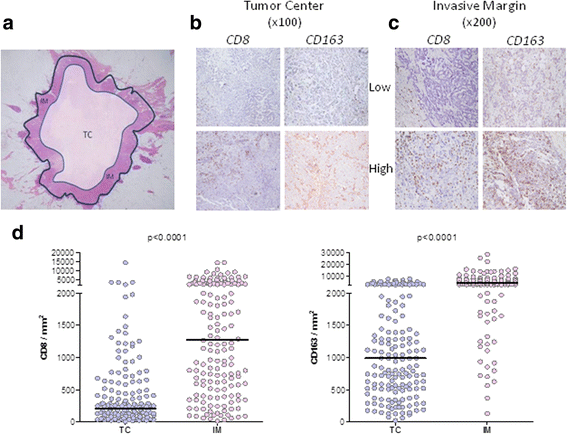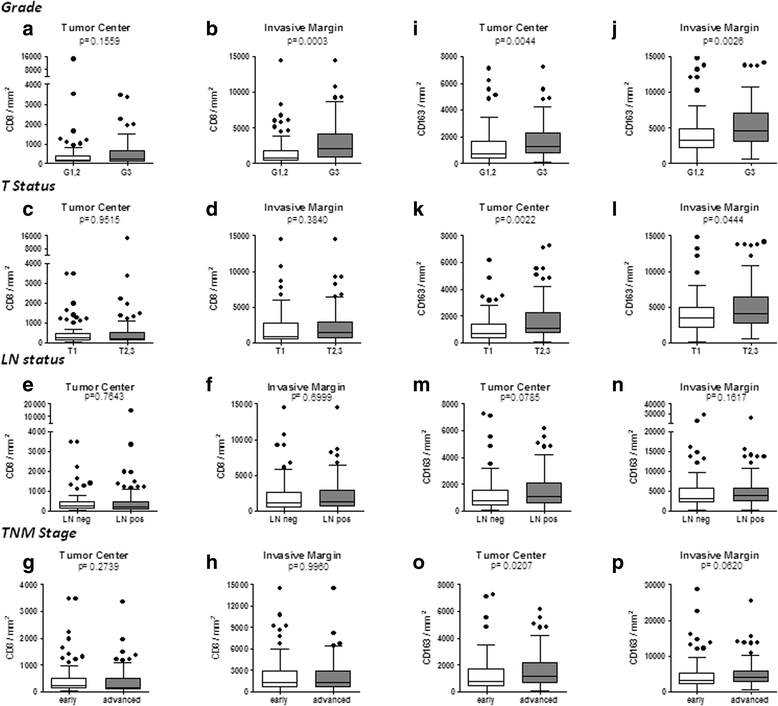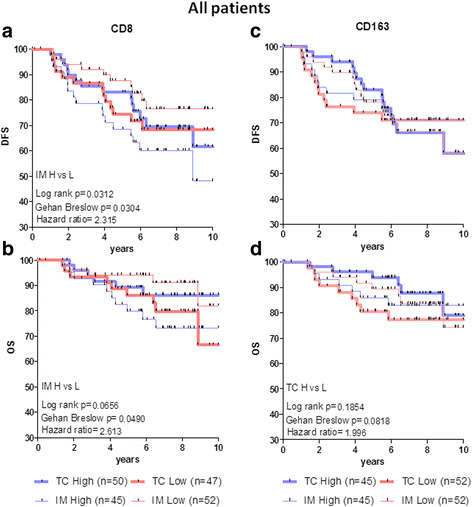Differential intratumoral distributions of CD8 and CD163 immune cells as prognostic biomarkers in breast cancer
- PMID: 28428887
- PMCID: PMC5395775
- DOI: 10.1186/s40425-017-0240-7
Differential intratumoral distributions of CD8 and CD163 immune cells as prognostic biomarkers in breast cancer
Erratum in
-
Erratum to: Differential intratumoral distributions of CD8 and CD163 immune cells as prognostic biomarkers in breast cancer.J Immunother Cancer. 2017 May 30;5:48. doi: 10.1186/s40425-017-0248-z. eCollection 2017. J Immunother Cancer. 2017. PMID: 28572978 Free PMC article.
Abstract
Background: Tumor immune cell infiltrates are essential in hindering cancer progression and may complement the TNM classification. CD8+ and CD163+ cells have prognostic impact in breast cancer but their spatial heterogeneity has not been extensively explored in this type of cancer. Here, their potential as prognostic biomarkers was evaluated, depending on their combined densities in the tumor center (TC) and the tumor invasive margin (IM).
Methods: CD8+ and CD163+ cells were quantified by immunohistochemistry of formalin-fixed, paraffin-embedded (FFPE) tumor tissue samples from a cohort totaling 162 patients with histologically-confirmed primary invasive non-metastatic ductal breast cancer diagnosed between 2000 and 2015. Clinical follow-up (median 6.9 years) was available for 97 of these patients.
Results: Differential densities of CD8+ and CD163+ cells in the combined TC and IM compartments (i.e., high(H)/low(L), respectively for CD8+ cells and the reverse L/H combination for CD163+ cells) were found to have significant prognostic value for survival, and allowed better patient stratification than TNM stage, tumor size, lymph node invasion and histological grade. The combined evaluation of CD8+ and CD163+ cell densities jointly in TC and IM further improves prediction of clinical outcomes based on disease-free and overall survival. Patients having the favorable immune signatures had favorable clinical outcomes despite poor clinicopathological parameters.
Conclusions: Given the important roles of CD8+ and CD163+ cells in regulating opposing immune circuits, adding an assessment of their differential densities to the prognostic biomarker armamentarium in breast cancer would be valuable. Larger validation studies are necessary to confirm these findings.
Trial registrations: Study code: IRB-ID 6079/448/10-6-13 Date of approval: 10/06/2013 Retrospective study (2000-2010) First patient prospectively enrolled 14/2/2014.
Keywords: Breast cancer; CD163; CD8; Immunoscoring; Prognostic signature; Tumor infiltration.
Figures






Similar articles
-
Prognostic Impact of CD163+ Macrophages in Tumor Stroma and CD8+ T-Cells in Cancer Cell Nests in Invasive Extrahepatic Bile Duct Cancer.Anticancer Res. 2017 Jan;37(1):183-190. doi: 10.21873/anticanres.11304. Anticancer Res. 2017. PMID: 28011489
-
Tumor cell expression of CD163 is associated to postoperative radiotherapy and poor prognosis in patients with breast cancer treated with breast-conserving surgery.J Cancer Res Clin Oncol. 2018 Jul;144(7):1253-1263. doi: 10.1007/s00432-018-2646-0. Epub 2018 May 3. J Cancer Res Clin Oncol. 2018. PMID: 29725763 Free PMC article.
-
CD68, CD163, and matrix metalloproteinase 9 (MMP-9) co-localization in breast tumor microenvironment predicts survival differently in ER-positive and -negative cancers.Breast Cancer Res. 2018 Dec 17;20(1):154. doi: 10.1186/s13058-018-1076-x. Breast Cancer Res. 2018. PMID: 30558648 Free PMC article.
-
The role of immune infiltrates as prognostic biomarkers in patients with breast cancer.Cancer Immunol Immunother. 2019 Oct;68(10):1671-1680. doi: 10.1007/s00262-019-02327-7. Epub 2019 Mar 23. Cancer Immunol Immunother. 2019. PMID: 30905043 Free PMC article. Review.
-
Immune cell infiltrates as prognostic biomarkers in pancreatic ductal adenocarcinoma: a systematic review and meta-analysis.J Pathol Clin Res. 2021 Mar;7(2):99-112. doi: 10.1002/cjp2.192. Epub 2021 Jan 22. J Pathol Clin Res. 2021. PMID: 33481339 Free PMC article.
Cited by
-
Serum miRNA-based distinct clusters define three groups of breast cancer patients with different clinicopathological and immune characteristics.Cancer Immunol Immunother. 2019 Jan;68(1):57-70. doi: 10.1007/s00262-018-2252-7. Epub 2018 Oct 1. Cancer Immunol Immunother. 2019. PMID: 30276443 Free PMC article.
-
Relationship between the immune microenvironment of different locations in a primary tumour and clinical outcomes of oesophageal squamous cell carcinoma.Br J Cancer. 2020 Feb;122(3):413-420. doi: 10.1038/s41416-019-0622-3. Epub 2019 Nov 25. Br J Cancer. 2020. PMID: 31761900 Free PMC article.
-
Radiomic models based on magnetic resonance imaging predict the spatial distribution of CD8+ tumor-infiltrating lymphocytes in breast cancer.Front Immunol. 2022 Dec 19;13:1080048. doi: 10.3389/fimmu.2022.1080048. eCollection 2022. Front Immunol. 2022. PMID: 36601118 Free PMC article.
-
Preoperative Systemic Inflammatory Biomarkers Are Independent Predictors of Disease Recurrence in ER+ HER2- Early Breast Cancer.Front Oncol. 2021 Nov 4;11:773078. doi: 10.3389/fonc.2021.773078. eCollection 2021. Front Oncol. 2021. PMID: 34804977 Free PMC article.
-
Prognostic value of various immune cells and Immunoscore in triple-negative breast cancer.Front Immunol. 2023 Apr 6;14:1137561. doi: 10.3389/fimmu.2023.1137561. eCollection 2023. Front Immunol. 2023. PMID: 37090736 Free PMC article.
References
Publication types
MeSH terms
Substances
LinkOut - more resources
Full Text Sources
Other Literature Sources
Medical
Research Materials
